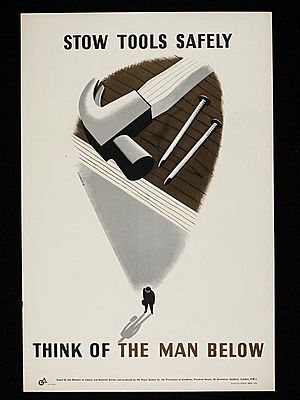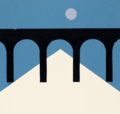Tom Eckersley facts for kids
Tom Eckersley (born September 30, 1914 – died August 4, 1997) was a famous English artist. He designed many posters and also taught design.
Contents
Early Life and Art Career
Tom Eckersley was born in Lancashire, England, in 1914. He started learning art in 1930 at Salford Art School. He was very talented and even won an award for being the best student.
In 1934, Tom moved to London. He wanted to become a poster designer who worked for himself. He went with Eric Lombers, another student who would later work with him. Tom was inspired by other famous poster artists like Adolphe Mouron Cassandre.
Tom and Eric Lombers created posters that looked good and also worked well for advertisers. They drew all the letters by hand. They also taught poster design at the Westminster School of Art. In the 1930s, posters were a main way to share messages with many people. This made their work very important.
Eckersley developed a special style. He used simple shapes and flat designs. He also used strong contrasts, like different sizes or bold lines. His style was similar to other modern designers in Europe. This simple, clear style was perfect for the safety posters he made for factories.
World War II Work
When World War II started in 1939, Tom and Eric's partnership ended. They joined different parts of the military. There was also less need for regular advertisements.
Because of this, Tom started making posters for the Royal Society for the Prevention of Accidents (RoSPA). These posters helped factory workers stay safe, especially those supporting the war effort. His posters were very direct. They used bright colors and cut-out shapes to get the message across with little text.
Tom first joined the Royal Air Force and drew maps. Later, he moved to the Air Ministry's Publicity Section. This allowed him to work from home and take on other jobs. For example, he designed posters for the General Post Office. In 1948, he received an award called the Order of the British Empire (OBE) for his great poster designs. During the war, people realized how powerful posters were for sharing important messages.
After the war, there were fewer government poster jobs. Money was tight, so commercial advertising was still limited. But Tom found new clients like Gillette and continued working for old ones like the General Post Office. He also illustrated books, including his wife's book Cat O'Nine Lives in 1946.
Eckersley as a Teacher
Tom Eckersley taught poster design at the Westminster School of Art from 1937 to 1939. In 1954, he joined the London College of Printing. Here, he started the first college courses in graphic design in Britain. He led the Graphic Design department from 1957 to 1977.
While teaching, he also designed posters for the college. For example, one poster reminded students to return library books. Tom also kept doing work for clients like UNICEF and the World Wide Fund for Nature. This mix of teaching and designing kept his work fresh and important. Many famous designers learned from Tom, including Ralph Steadman and John Hegarty.
Eckersley's Impact and Legacy
Tom Eckersley was one of the most important poster designers and communicators of his time. He was both a working artist and a teacher. Besides posters and book illustrations, he also designed magazine covers and logos.
His designs often used abstract shapes and collage. No matter the technique, his designs always brought together words and pictures to share complex messages simply. Many different companies hired him, showing how popular his striking designs were. These included Shell-Mex & BP, the BBC, London Transport, and the Imperial War Museum. He also designed posters for events, like a seminar he gave in Sweden in 1960.
Eckersley's Collection and Later Years
Tom Eckersley kept copies of many of his posters and original artworks. These were like his sketchbooks. He used them for teaching and as a personal reference. He kept them at his home, creating his own collection. He also designed posters just for fun, like a series of film posters with famous Hollywood faces. These were only shown at small events, like exhibitions of his work.
Tom Eckersley passed away in 1997. Two years before, an exhibition of his work was held at the London College of Communication. A review said that he had changed graphic design in the UK.
The University of the Arts London has a collection of his posters, magazine covers, and original artwork. You can see many of his posters online on VADS (Visual Arts Data Service).
Images for kids
-
Eckersley artwork on the Victoria line
See also
- Richard Eckersley (his son)





